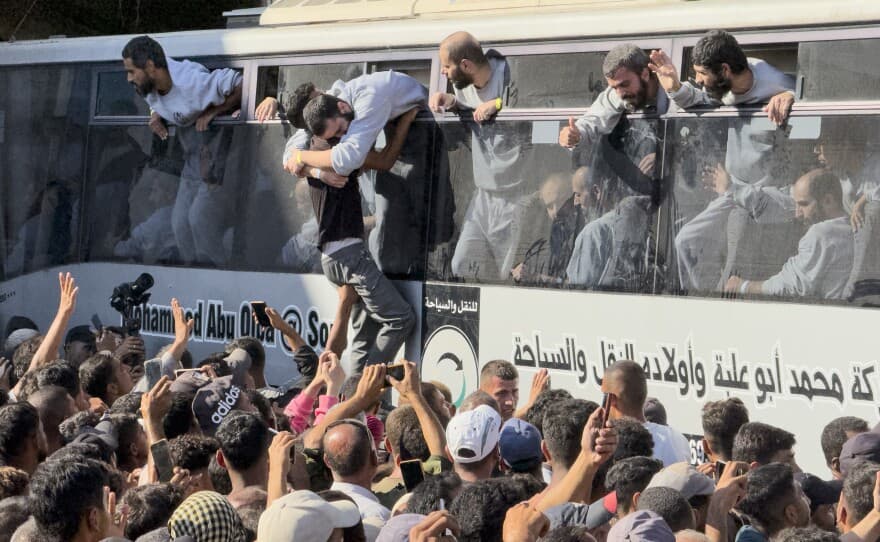Loading News Article...
We're loading the full news article for you. This includes the article content, images, author information, and related articles.
We're loading the full news article for you. This includes the article content, images, author information, and related articles.
The Gaza Humanitarian Foundation (GHF), a US and Israeli-backed aid organisation, has ceased operations in Gaza following the October 10 ceasefire, raising concerns about humanitarian aid distribution in the war-torn enclave.

The Gaza Humanitarian Foundation (GHF), a controversial aid organisation supported by the United States and Israel, confirmed the suspension of its operations in Gaza after a ceasefire agreement between Israel and Hamas took effect on Thursday, October 10, 2025. Despite having funding secured until November, the GHF stated its final aid delivery occurred on Friday, October 11, 2025.
The suspension comes amidst ongoing criticism of the GHF, particularly after hundreds of Palestinians were reportedly killed near its distribution sites while attempting to collect food. Witnesses have largely attributed these deaths to Israeli forces. However, Israel has consistently denied that its troops fired on civilians at or near these sites, and the GHF has maintained that its aid distribution was carried out "without incident."
The GHF commenced operations in Gaza on May 27, 2025, following a nearly three-month Israeli blockade that exacerbated a severe humanitarian crisis. The organisation was established with the stated aim of distributing aid directly to Gazan families, thereby circumventing Hamas, which Israel accused of diverting supplies. However, the GHF's model, which involved operating in Israeli-controlled areas with private security contractors, drew significant condemnation from the United Nations and other international aid agencies.
Critics argued that the GHF's approach violated core humanitarian principles, politicised aid, and endangered civilians by requiring them to travel through militarised zones to reach distribution points. The UN, for instance, refused to collaborate with the GHF, citing concerns about neutrality and independence. Reports from Gaza's Health Ministry, its Civil Defense Agency, and health workers indicate at least 18 incidents of violence at GHF aid centres since their inception, resulting in numerous fatalities. The UN reported that at least 613 Palestinians were killed while collecting aid since the GHF began operations, with 509 of these deaths occurring at GHF centres.
Israel, through its military and government spokespersons, has repeatedly denied intentionally targeting civilians at aid sites, often attributing casualties to warning shots or to Hamas gunmen firing on crowds. The GHF itself has also denied reports of violence at its sites, urging journalists to verify facts.
The recent ceasefire agreement between Israel and Hamas, which included a hostage-prisoner exchange and a halt to Israeli bombardments, has provisions for increased humanitarian aid into Gaza. The agreement stipulates that at least 600 trucks of aid should enter Gaza daily and allows for free movement between northern and southern Gaza on the two main roads. However, aid organisations have expressed concerns that the number of trucks permitted is still insufficient to meet the catastrophic needs.
Significantly, a humanitarian annex within the ceasefire deal does not explicitly mention a role for the Gaza Humanitarian Foundation in post-war humanitarian operations. Instead, it states that "UN agencies, other organizations, the Red Crescent and countries operating in the Strip will receive and distribute aid." This omission, coupled with the GHF's reported funding challenges, suggests a diminished role, if any, for the organisation in future aid efforts.
The GHF's northernmost distribution site, SDS4, was reportedly shut down because it was no longer in Israeli Defense Forces (IDF)-controlled territory. Satellite imagery indicates the site was dismantled shortly after the October 10 ceasefire. A GHF spokesman stated, "Right now we're paused. We feel like there's still a need, a surge for as much aid as possible. Our goal is to resume aid distribution."
Kenya has actively engaged with the humanitarian situation in Gaza, welcoming the first phase of the ceasefire agreement as a "vital step in easing human suffering." Nairobi has praised the truce's provisions, including the entry of humanitarian aid into the Gaza Strip. The Kenyan government has consistently expressed concern over the worsening humanitarian situation and has echoed calls by the United Nations and human rights groups for unrestricted aid delivery.
While President William Ruto has reaffirmed Kenya's support for Israel, he has also stressed that the conflict should not be resolved by military means and has advocated for a two-state solution. Kenyan Members of Parliament have also condemned the atrocities in Gaza, calling for an immediate ceasefire and the recognition of Palestine.
The coming weeks will be crucial in determining the long-term impact of the ceasefire on humanitarian aid delivery in Gaza. Key aspects to monitor include the consistent implementation of aid access provisions, the reopening of all crossing points into Gaza, and the ability of UN agencies and other established humanitarian organisations to scale up their operations effectively. The future role of the Gaza Humanitarian Foundation, if any, in the evolving aid landscape also remains uncertain.
Keep the conversation in one place—threads here stay linked to the story and in the forums.
Other hot threads
E-sports and Gaming Community in Kenya
Active 6 months ago
Popular Recreational Activities Across Counties
Active 6 months ago
The Role of Technology in Modern Agriculture (AgriTech)
Active 6 months ago
Investing in Youth Sports Development Programs
Active 6 months ago